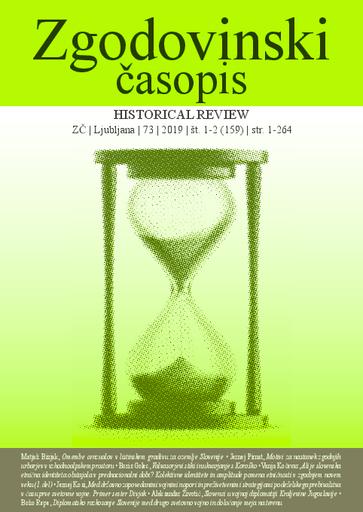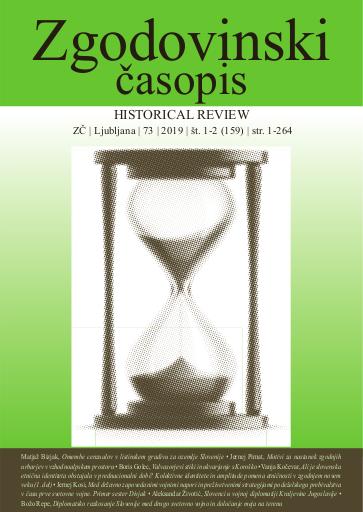/
Serijske publikacije
/
Zgodovinski časopis
Diplomatsko razkosanje Slovenije med drugo svetovno vojno in določanje meja na terenu

Avtor(ji):Božo Repe
Soavtor(ji):Peter Štih (odg. ur.), Saša Mlacović (prev.), Vesna Vidmar (drugo)
Leto:2019
Založnik(i):Zveza zgodovinskih društev Slovenije
Jezik(i):slovenščina, angleščina
Vrst(e) gradiva:besedilo
Ključne besede:Slovenija, okupacija, razkosanje, aneksionizem, debelacija, mejne komisije, določanje meja, Slovenia, occupation, division, annexationism, debellation, border committees, delineation of borders
Avtorske pravice:

To delo avtorja Božo Repe je ponujeno pod Creative Commons Priznanje avtorstva-Nekomercialno-Brez predelav 4.0 Mednarodna
Datoteke (1)

Ime:ZC_2019_1-2.pdf
Velikost:11.75MB
Format:application/pdf
Stalna povezava:https://hdl.handle.net/11686/file25389
Opis
Članek obravnava okupacijske meje v Sloveniji med drugo svetovno vojno. Z zasedbo slovenskega etničnega ozemlja je bilo leta 1941 na Slovenskem pet različnih mejnih območij in meja. Te so bile: meja med Nemčijo in Madžarsko, meja med Madžarsko in NDH, meja med Nemčijo in NDH, meja med Italijo in Nemčijo ter meja med Italijo in NDH. Kljub formalni vključitvi t. i. Ljubljanske pokrajine v Italijo je še vedno ostala tudi t. i. rapalska meja, ki je ločevala primorske Slovence od preostalih. Vzpostavitev meja z žičnimi ogradami, minskimi polji, bunkerji in stražnimi stolpi so okupatorji pospremili z vojnim nasiljem, deportacijami prebivalstva, pogosti so bili tudi prebegi iz ene okupacijske cone v drugo. Vse to je neizogibno povzročilo številne travme ter pretrgalo tradicionalne vzorce migracij, kmetovanja in trgovine.
Metapodatki (12)
- identifikatorhttps://hdl.handle.net/11686/41445
- naslov
- Diplomatsko razkosanje Slovenije med drugo svetovno vojno in določanje meja na terenu
- Diplomatic Division of Slovenia during World War II and On-Site Delineation of Borders
- ustvarjalec
- Božo Repe
- soavtor
- Peter Štih (odg. ur.)
- Saša Mlacović (prev.)
- Vesna Vidmar (drugo)
- predmet
- Slovenija
- okupacija
- razkosanje
- aneksionizem
- debelacija
- mejne komisije
- določanje meja
- Slovenia
- occupation
- division
- annexationism
- debellation
- border committees
- delineation of borders
- opis
- The article deals with occupiers’ borders in Slovenia on several levels: a rough division of the Slovene territory at the highest (predominately German) level and international treaties (if concluded) based on the principle of debellation of Yugoslavia; the military occupation of a territory; marking the area on location (with occasional confl icts between otherwise allied countries); actual delineation conducted by border committees; and the consolidation of the border. By pointing out shared characteristic features, the article also highlights differences between respective borders and occupiers. The occupation of the Slovene ethnic territory in 1941 resulted in fi ve different border areas and borders. Namely, the border between Germany and Hungary, Hungary and NDH, Germany and NDH, Italy and Germany, and between Italy and NDH. Despite the formal annexation of the so-called Ljubljana Province to Italy, the Rapallo border remained in place, separating Slovenes in the Littoral from Slovenes elsewhere. The length of all borders totalled 640 km (bearing in mind that the Slovene territory encompasses upwards of 20,000 km2 ). The formation of borders by way of barbed wire fences, mine fi elds, bunkers, and watchtowers was accompanied by violence, deportations, escapes from one occupation zones to another. At the same time the borders were crossed illegally because of life’s necessities and the Partisan resistance, which did not acknowledge the division and fought against it. Inevitably, all this led to many traumas and broke off traditional patterns of migration, farming, and trade. Research, from which the article draws, is based on diplomatic and military sources, geographic measurements, tracing borders on location, identifi cation of its remnants, and systematic gathering of memories, their processing, preparing for publication, and analysis. By involving students and people on location, publishing results, and interacting with local milieus, forestry services, hunting associations, and individuals interested in the subject, it follows the concept of the so-called public history. The research paints a historical picture, which depicts the borders’ signifi cance for Slovenes’ fate on the national level and on that of border areas and individuals; in doing so, it demonstrates dimensions of occupiers’ ethnocidal and genocidal actions, and the transformation of the demographic and national structure in the territory that they had to leave behind in 1945.
- založnik
- Zveza zgodovinskih društev Slovenije
- datum
- 2019
- 01. 05. 2019
- tip
- besedilo
- jezik
- Slovenščina
- Angleščina
- jeDelOd
- pravice
- licenca: ccByNcNd
